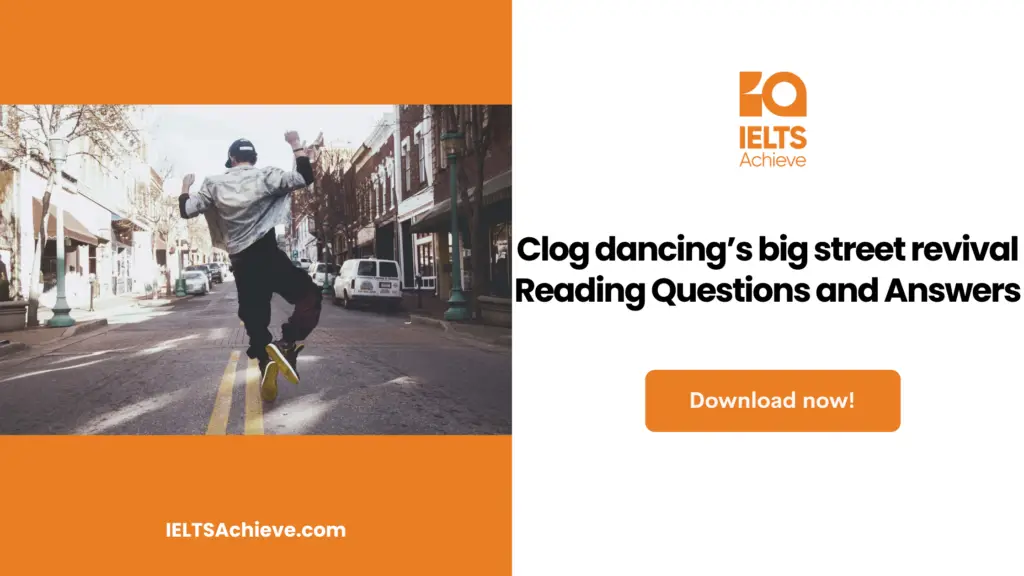The Blog post contains the following IELTS Reading Questions:
- IELTS Reading Matching Headings
- IELTS Reading Summary Completion
- IELTS Reading Notes Completion
Stay informed and prepared for success – Explore our comprehensive Reading Test Info page to get valuable insights, exam format details, and expert tips for mastering the IELTS Reading section.
IELTS Reading passage – Clog dancing’s big street revival

Clog dancing’s big street revival
A.The streets of Newcastle, in the north-east of England, have begun to echo with a sound that has not been heard for about a century. A sharp, rhythmic knocking can be heard among the Saturday crowds in one of the city’s busiest intersections. It sounds a little like dozens of horses galloping along the street, but there are none in sight. In fact, it’s the noise of a hundred people dancing in wooden shoes, or clogs.The shoppers are about to be ambushed by the UK’s biggest clog dance event. The hundred volunteers have been coached to perform a mass routine. For ten minutes, the dancers bring the city centre to a standstill. There are people clogging on oil drums and between the tables of pavement cafes. A screaming, five-man team cuts through the onlookers and begins leaping over swords that look highly dangerous. Then, as swiftly as they appeared, the doggers melt back into the crowd, leaving the slightly stunned spectators to go about their business.
B.This strange manifestation is the brainchild of conductor Charles Hazlewood, whose conversion to clog dancing came through an encounter with a folk band. The Unthanks. ‘Rachel and Becky Unthank came to develop some ideas in my studio,’ Hazlewood says. ‘Suddenly, they got up and began to mark out the rhythm with their feet – it was an extraordinary blur of shuffles, clicks and clacks that was an entirely new music for me. I thought, “Whatever this is, I want more of it”.’Hazlewood was inspired to travel to Newcastle to make a television programme, Come Clog Dancing, in which he and a hundred other people learn to clog in a fortnight. Yet when he first went out recruiting, local people seemed unaware of their heritage. ‘We went out on to the streets, looking for volunteers, but nobody seemed to know anything about clog dancing; or if they did, they thought it originated in the Netherlands.’
C.The roots of clog dancing go back several hundred years, and lie in traditional dances of the Dutch, Native Americans and African-Americans, in which the dancer strikes the ground with their heel or toes, to produce a rhythm that’s audible to everyone around. In England, clogging is believed to have first developed in the mid-19th century in the cotton mills of Lancashire, in the north-west, where workers created a dance that imitated the sound of the machinery. The style quickly spread and developed a number of regional variations. In Northumberland, it became a recreation for miners, who danced solo or to the accompaniment of a fiddle.‘The Northumberland style is very distinct from Lancashire clogging,’ says Laura Connolly, a virtuoso dancer who worked with Hazlewood on the programme. ‘Northumbrian dancing is quite neat and precise with almost no upper-body movement, whereas the Lancastrian style is more flamboyant.’
D.Whatever the region, clogging remains very much a minority pursuit. Yet at the turn of the 20th century, clogging was a fully-fledged youth craze. Two famous comic film actors, Stan Laurel and Charlie Chaplin, both began their careers as doggers. But the dance almost completely died out with the passing of the industrial age. ‘People danced in clogs because they were cheap, hardwearing and easily repaired,’ Connolly says. ‘Yet eventually, clogs became associated with poverty and people were almost ashamed to wear them.’
E.Fortunately, the key steps of the dances were preserved and handed down in a series of little blue books, often named after their inventors. ‘It means that we still know what Mrs Willis’s Rag or Ivy Sands’s Hornpipe were like,’ Connolly says. ‘It’s my dream that one day there’ll be a little blue book called Laura Connolly’s Jig.’
F.Her biggest challenge to date was to teach Hazlewood and 100 other beginners a routine sufficiently accomplished to perform on television, from scratch, in less than two weeks. ‘I started people off with something simple,’ she says. ‘It’s a basic shuffle that most people can pick up/ Once Hazlewood had absorbed the basics, Connolly encouraged him to develop a short solo featuring more complex steps – though he nearly came to grief attempting a tricky manoeuvre known as Charlie Chaplin Clicks, so named as it was the signature move of Chaplin’s film character the Little Tramp.‘To be honest, I never quite got those right,’ Hazlewood says with a laugh. ‘We came up with a slightly easier version, which Laura thought we should call Charlie Hazlewood Clicks. The thing about clogs is that they’re all surface: there’s no grip and they’re slightly curved so you stand in a slightly peculiar way. The potential to fall over is enormous.’On the day, Hazlewood managed to pull off a decent solo, clicks and all. T wasn’t convinced, until the moment I did it, that I was going to get it right,’ he admits. ‘But in the end, clog dancing is not so very different from conducting. Both require you to communicate a beat – only 1 had to learn how to express it with my feet, rather than my hands. But it’s a good feeling.
’G.‘People forget that clogging was originally a street dance,’ Connolly says. ‘It was competitive, it was popular, and now young people are beginning to rediscover it for themselves. As soon as we finished in Newcastle, I had kids coming up to me saying, “Clog dancing’s cool – I want to do that!”’
Unlock your full potential in the IELTS Reading section – Visit our IELTS Reading Practice Question Answer page now!
Recommended Questions:
Renewable Energy IELTS Reading Question with Answer
Questions 28-34
The following reading passage has seven sections, A-G. Choose the correct heading for each section from the list of headings below. Write the correct number, i-x, in boxes 28-34 on your answer sheet.
List of Headings
i. The instructions for old dances survive
ii. Inspired by foreign examples
iii. Found in a number of countries and districts
iv. An enthusiastic response from certain people
v. Spectators join in the dancing
vi. How the street event came about
vii. From the height of popularity to a fall from fashion
viii. A surprise public entertainment
ix. Young people invent their own clog dances
x. Clog dancing isn’t so easy
28. Section A ………………………
29. Section B ………………………
30. Section C ………………………
31. Section D ………………………
32. Section E ………………………
33. Section F ………………………
34. Section G ………………………
Ready to conquer Matching Headings questions? Click here to learn essential tips and techniques for matching headings accurately to paragraphs or sections in the IELTS Reading section.
Questions 35-37
Complete the summary below. Choose NO MORE THAN TWO WORDS from the text for each answer.Write your answers in boxes 35-37 on your answer sheet.
A clog dancing event in Newcastle
First the city’s shoppers hear a sound that seems to be created by a large number of 35 …………………, and then over a hundred people wearing clogs appear and dance. Most dance on the pavement, some on oil drums. One group uses 36 ………………… as part of its dance. The event was organised by Charles Hazlewood, a 37 ………………… . He was introduced to clog dancing by a folk band working with him in his studio.
Boost your performance in Summary, Notes, Table, and Flowchart Completion tasks. Click here to explore our detailed guide and learn how to effectively complete summaries, notes, tables, and flowcharts in the IELTS Reading section.
Questions 38-40
Complete the notes below. Choose ONE WORD ONLY from the text for each answer. Write your answers in boxes 38-40 on your answer sheet.
The origins of clog dancing
• Originated in the Netherlands and North America
• In England, probably invented by factory workers copying the noise made by the 38 ………………… in mills
• In Northumberland, was danced by 39 ………………….
• Very popular in the early 20th century
• Lost popularity when clogs were thought to indicate 40 …………………
Boost your performance in Summary, Notes, Table, and Flowchart Completion tasks. Click here to explore our detailed guide and learn how to effectively complete summaries, notes, tables, and flowcharts in the IELTS Reading section.
Unlock your full potential in the IELTS Reading section – Visit our IELTS Reading Practice Question Answer page now!
Recommended Questions:
Renewable Energy IELTS Reading Question with Answer
Answer:
28. viii
29. vi
30. iii
31. vii
32. i
33. x
34. iv
35. horses (galloping)
36. swords
37. conductor
38. machinery
39. miners
40. poverty

We hope you found this post useful in helping you to study for the IELTS Test. If you have any questions please let us know in the comments below or on the Facebook page.
The best way to keep up to date with posts like this is to like us on Facebook, then follow us on Instagram and Pinterest. If you need help preparing for the IELTS Test, join the IELTS Achieve Academy and see how we can assist you to achieve your desired band score. We offer an essay correction service, mock exams and online courses.

